We understand how hard is it to livein Cold weather or in Winters, Miras Crafts ® Presents Real Warm Pashmina Woool From the Himaliyas Of Kashmir.
Pashmina is a fine type of cashmere wool. The textiles made from it were first woven in Kashmir.The name comes from Persian:پشمینه / pašmina, meaning "made from wool and literally translates to "Soft Gold" in Kashmiri. The wool comes from four distinct breeds of the Cashmere goat; namely the Changthangi or Kashmir Pashmina goat from the Changthang plateau in Kashmir region, the Malra from Kargil area in Kashmir region, the Chegu from Himachal Pradesh in northern India, and Chyangara or Nepalese Pashmina goat from Nepal. Pashmina shawls are hand spun, and woven in Kashmir and Nepal, and made from fine cashmere fibre
The fibre is also known as pashm or pashmina for its use in the handmade shawls of the Himalayas. The woolen shawls made inKashmir are mentioned in Afghan texts between the 3rd century BC and the 11th century AD. However, the founder of the Pashmina industry is traditionally held to be the 15th century ruler of Kashmir, Zayn-ul-Abidin, who introduced weavers from Central Asia and even today, the master craftsmen in Kashmir pay tribute at his grave
Cashmere shawls have been manufactured in Nepal and Kashmir for thousands of years. The test for a quality pashmina is warmth and feel. Pashmina and Cashmere are derived from the "capra hircus" mountain goat. One distinct difference between Pashmina and generic Cashmere is the fibre diameter. Pashmina fibres are finer and thinner (11-15 microns) than generic cashmere fibre (15-19 microns), and therefore, ideal for making light weight apparel like fine scarves. Today, however, the word "Pashmina" has been used too liberally and many scarves made from natural or synthetic fiber are sold as Pashmina creating confusion in the market. The exorbitant price of a Pashmina shawl is due to the quantum of expert craftsmanship that goes into creating each shawl and the rarity of the Pashmina wool - the wool is used in an authentic Kashmiri Pashmina comes from the Changthangi breed of the capra hircus goat and this breed constitutes less than 0.1% of global Cashmere production.
As the fibre diameter is very low, Pashmina has to be hand-processed and woven into products such as shawls, scarves, wraps, throws, stoles, etc. However, the quality of a finished shawl is not solely dependent on the fibre diameter of the wool but also on the craftsmen's skills. Pashmina products are made only in Kashmir and more recently in Nepal where the industry has seen a surge in production.



